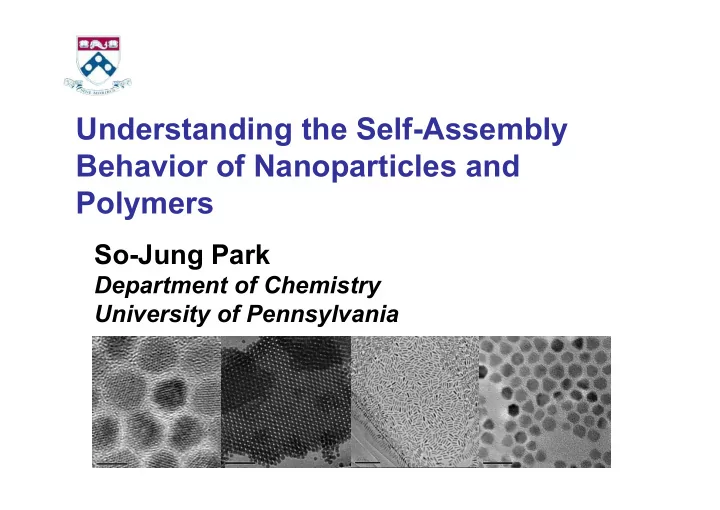

Understanding the Self-Assembly Behavior of Nanoparticles and Polymers So-Jung Park Department of Chemistry University of Pennsylvania
Inorganic Nanoparticle/Polymer Hybrid Materials for Alternative Energy R CdSe nanocrystals R H R n n R H H S
Overview 1. Cooperative Assembly of Nanoparticles and Block-Copolymers
Inorganic Nanoparticle/Polymer Hybrid Materials for Alternative Energy R CdSe nanocrystals R H R n n R H H S
Overview 1. Cooperative Assembly of Nanoparticles and Block-Copolymers 2. Self-Organizing Organic Electronic Materials
Cooperative Assembly of Nanoparticles and Block-Copolymers Random Incorporation of Interfacial Assembly of Nanoparticles as Simple Solutes Nanoparticles
Interfacial Assembly of Quantum Dots in Discrete Block-Copolymer Aggregates Co-assemblies of PAA 41 - b -PS 193 and CdSe nanocrystals in water Cavity-like Structure of Nanoparticles • Polymer shell: A monolayer of block-copolymers with PAA at the exterior • Polymer core: Reverse micelles of block-copolymers • QDs arranged at the interface between the polymer core and the polymer shell. Park and coworkers, Angew. Chem. Int. Ed. , 2007 , 119, 9395.
Origin of the Interfacial Assembly • Enthalpic Effect • Entropic Effect H O O 100 nm
Control of the Location of Nanoparticles # of QDs Polymer/QD = 100 Polymer/QD = 400
Distance Dependence Studies Using the Controllable Shell Thickness No silver: 84.38 ± 50.66 cts/ms with silver: 281.59 ± 126.01 cts/ms
What Controls the Structural Parameters? PAA 38 - b -PS 108 PAA 38 - b -PS 154 PAA 38 - b -PS 189 PAA 38 - b -PS 247
Nanoparticle Size Determines the Size of Co-assemblies 25 nm iron oxide particles 200 nm 4 nm iron oxide particles 200 nm
The Incorporation of Nanoparticles Reduces the Size Distribution. Polymer only BCP micelles 70 60 50 Frequency 40 30 20 10 200 nm 0 50 100 150 200 250 QD-BCP 60 Polymer + QDs Assemblies 50 Frequency 40 30 20 10 200 nm 0 50 100 150 200 250 Diameter (nm) • Nanoparticles narrow the size distribution of the assemblies formed. • As the concentration of nanoparticles is decreased, the size distribution gradually gets larger.
Nanoparticle-Induced Morphological Changes Polymer only Polymer + QDs • Nanoparticles play an active role in the block-copolymer assembly processes rather than simply being incorporated passively in the hydrophobic domain as solutes. • Nanoparticles cause a drastic morphology change of block copolymer assemblies.
Morphological Transition Induced by Nanoparticle Clustering
Membrane Curvature Change Induced by Nanoparticle clustering Figure 2: Clathrin-coated vesicle budding where yolk protein is being incorporated into vesicles in oocytes. Taken from McMahon et al. Nature, 438, 590 (2005).
Overview 1. Cooperative Assembly of Nanoparticles and Block-Copolymers 2. Self-Organizing Organic Electronic Materials
Self-Organizing, Optically Active Organic Materials IR
Reversible Morphology and Emission Color Changes
Fine Tuning of Emission Colors: Salt Effect
Self-Assembled Building Blocks for Inorganic/Organic Hybrid Materials Nanotubes wrapped in conjugated block- copolymers
Summary § Nanoparticles play an active role in the self-assembly process of block-copolymers, and they can drastically alter the behavior of polymers and the co-assembly structure. § Cooperative self-assembly of nanoparticles and block-copolymers offer a facile way to control the arrangement of nanoparticles in discrete block-copolymer assemblies. We developed conjugated block-copolymers that can self-assemble § into various morphologies including core-shell particles, rods, nanowires and layered structures. § Their band gap and the photoluminescent properties are highly tunable by simply controlling their assembly structures.
Acknowledgements Hao Sun Xi-Jun Chen Rob Hickey Amanda Kamps Brenda Sanchez-Gaytan Sang-Jae Park Helen Cativo (not pictured) Zhaoxia Qian (not pictured) Collaborators Funding NSF Career Award Prof. Mike Fryd, Upenn ARO Young Investigator Award Prof. Nigel Clarke, Durham University, UK
Recommend
More recommend